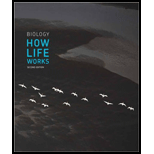
Concept explainers
To predict:
The type of fatty acids in the animal fats, fish and plant fats.
Introduction:
The lipids are the biological molecules, which are soluble in non-polar solvents such as benzene. The lipids consist of phospholipids, glycerides, sterols, waxes, fats, and fat-soluble vitamins. The animal fats are generally solid at room temperature and the plant or fish oil is liquid at room temperature.
Explanation of Solution
The fats are the triglyceride molecules which are comprised of three fatty acid chains attached to the glycerol molecule through the ester linkages. The fatty acid chains are the long hydrocarbon chains which may be saturated (lack any double bond) or unsaturated (have double bonds).
The saturated fatty acids in the animal fats are tightly packed; hence they have a higher melting point in comparison to the unsaturated fats. The tight packaging of the saturated fatty acids in the animal fats provides solid structure to it.
The unsaturated fatty acids in the plant and the fish oils have kinks in their structure, which prevent the tight packaging. So the melting point is low. The loose packaging of the unsaturated fatty acids is responsible for the liquid nature of the plant and fish fat.
The presence and absence of the double bond in the fatty acids of the fats are responsible for the solid and liquid nature of the fats. The unsaturated fatty acids cannot be packed tightly. The plant and fish fats have unsaturated fatty acids, so they are liquid at room temperature.
Want to see more full solutions like this?
Chapter 5 Solutions
Biology: How Life Works 2e & LaunchPad for Biology: How Life Works (Twenty-Four Month Access)
 Human Anatomy & Physiology (11th Edition)BiologyISBN:9780134580999Author:Elaine N. Marieb, Katja N. HoehnPublisher:PEARSON
Human Anatomy & Physiology (11th Edition)BiologyISBN:9780134580999Author:Elaine N. Marieb, Katja N. HoehnPublisher:PEARSON Biology 2eBiologyISBN:9781947172517Author:Matthew Douglas, Jung Choi, Mary Ann ClarkPublisher:OpenStax
Biology 2eBiologyISBN:9781947172517Author:Matthew Douglas, Jung Choi, Mary Ann ClarkPublisher:OpenStax Anatomy & PhysiologyBiologyISBN:9781259398629Author:McKinley, Michael P., O'loughlin, Valerie Dean, Bidle, Theresa StouterPublisher:Mcgraw Hill Education,
Anatomy & PhysiologyBiologyISBN:9781259398629Author:McKinley, Michael P., O'loughlin, Valerie Dean, Bidle, Theresa StouterPublisher:Mcgraw Hill Education, Molecular Biology of the Cell (Sixth Edition)BiologyISBN:9780815344322Author:Bruce Alberts, Alexander D. Johnson, Julian Lewis, David Morgan, Martin Raff, Keith Roberts, Peter WalterPublisher:W. W. Norton & Company
Molecular Biology of the Cell (Sixth Edition)BiologyISBN:9780815344322Author:Bruce Alberts, Alexander D. Johnson, Julian Lewis, David Morgan, Martin Raff, Keith Roberts, Peter WalterPublisher:W. W. Norton & Company Laboratory Manual For Human Anatomy & PhysiologyBiologyISBN:9781260159363Author:Martin, Terry R., Prentice-craver, CynthiaPublisher:McGraw-Hill Publishing Co.
Laboratory Manual For Human Anatomy & PhysiologyBiologyISBN:9781260159363Author:Martin, Terry R., Prentice-craver, CynthiaPublisher:McGraw-Hill Publishing Co. Inquiry Into Life (16th Edition)BiologyISBN:9781260231700Author:Sylvia S. Mader, Michael WindelspechtPublisher:McGraw Hill Education
Inquiry Into Life (16th Edition)BiologyISBN:9781260231700Author:Sylvia S. Mader, Michael WindelspechtPublisher:McGraw Hill Education





